ECON11026 Principles: Market Structures, Firm Behavior and Analysis
VerifiedAdded on 2023/04/22
|13
|1772
|373
Homework Assignment
AI Summary
This economics assignment delves into various market structures, including perfect competition, natural monopolies, and oligopolies, analyzing firm behavior within each. It explains why perfectly competitive firms are price takers, illustrating short-run losses, short-run economic profits, and long-run normal profits with graphs. The document also discusses the inefficiencies associated with monopolies and the concept of interdependence in oligopolies. Furthermore, it contrasts monopolistic and perfectly competitive markets, highlighting differences in firm numbers, pricing strategies, and product homogeneity. Finally, the assignment classifies goods into private, public, common resources, and club goods, providing an analysis of marginal social benefit and cost in relation to environmental impact. This resource is available on Desklib, a platform offering a wide range of study tools and solved assignments for students.
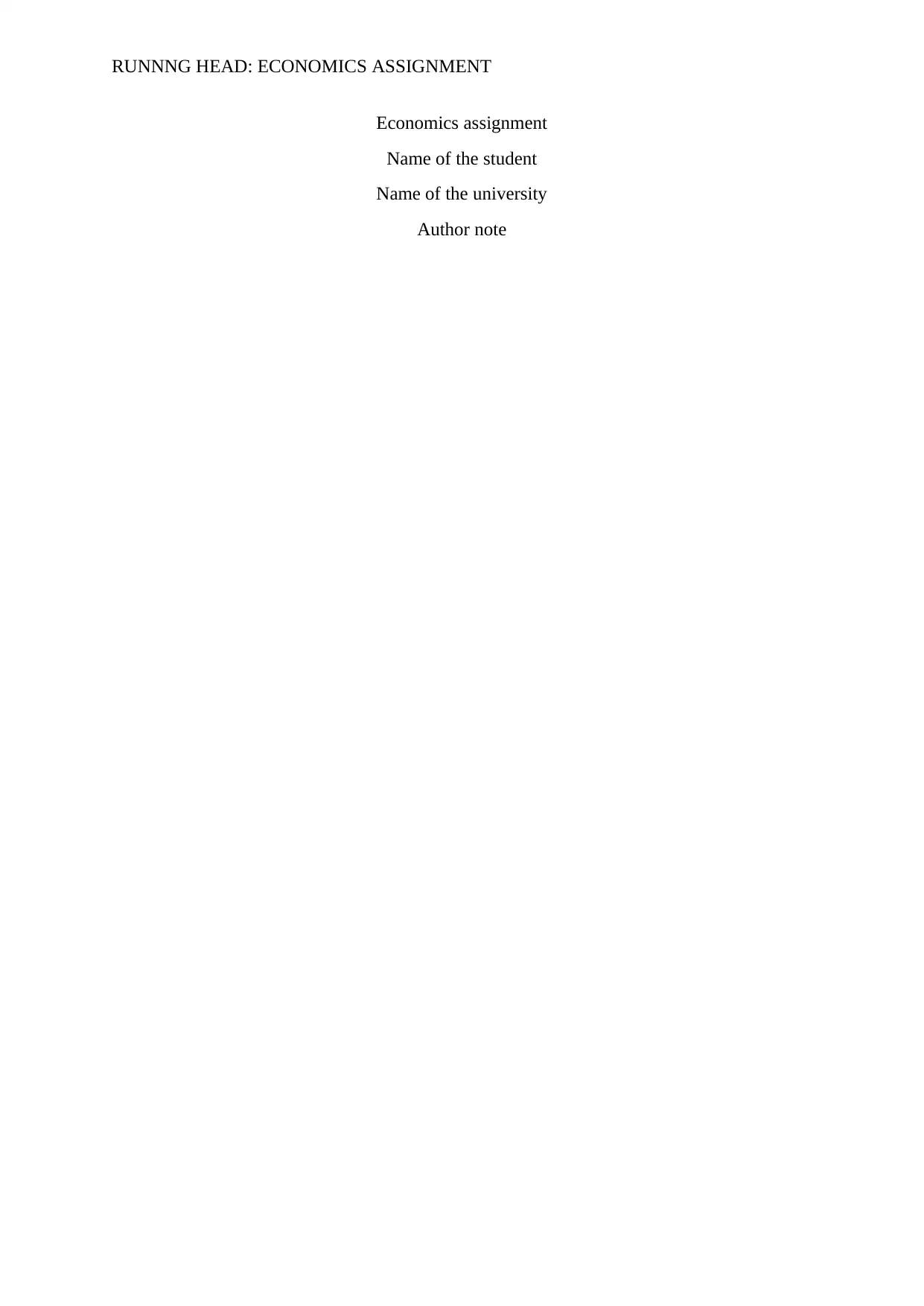
RUNNNG HEAD: ECONOMICS ASSIGNMENT
Economics assignment
Name of the student
Name of the university
Author note
Economics assignment
Name of the student
Name of the university
Author note
Paraphrase This Document
Need a fresh take? Get an instant paraphrase of this document with our AI Paraphraser
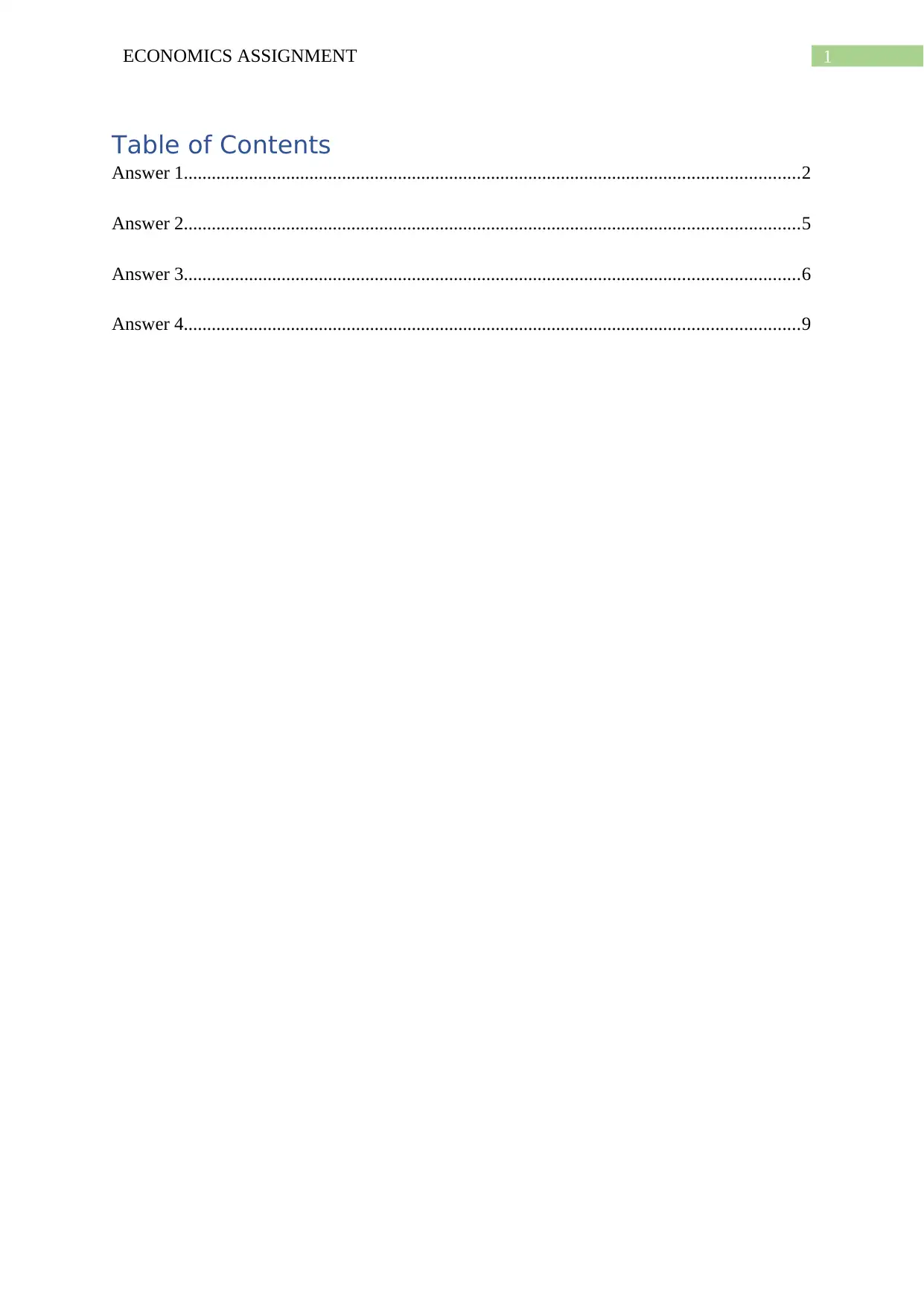
1ECONOMICS ASSIGNMENT
Table of Contents
Answer 1....................................................................................................................................2
Answer 2....................................................................................................................................5
Answer 3....................................................................................................................................6
Answer 4....................................................................................................................................9
Table of Contents
Answer 1....................................................................................................................................2
Answer 2....................................................................................................................................5
Answer 3....................................................................................................................................6
Answer 4....................................................................................................................................9
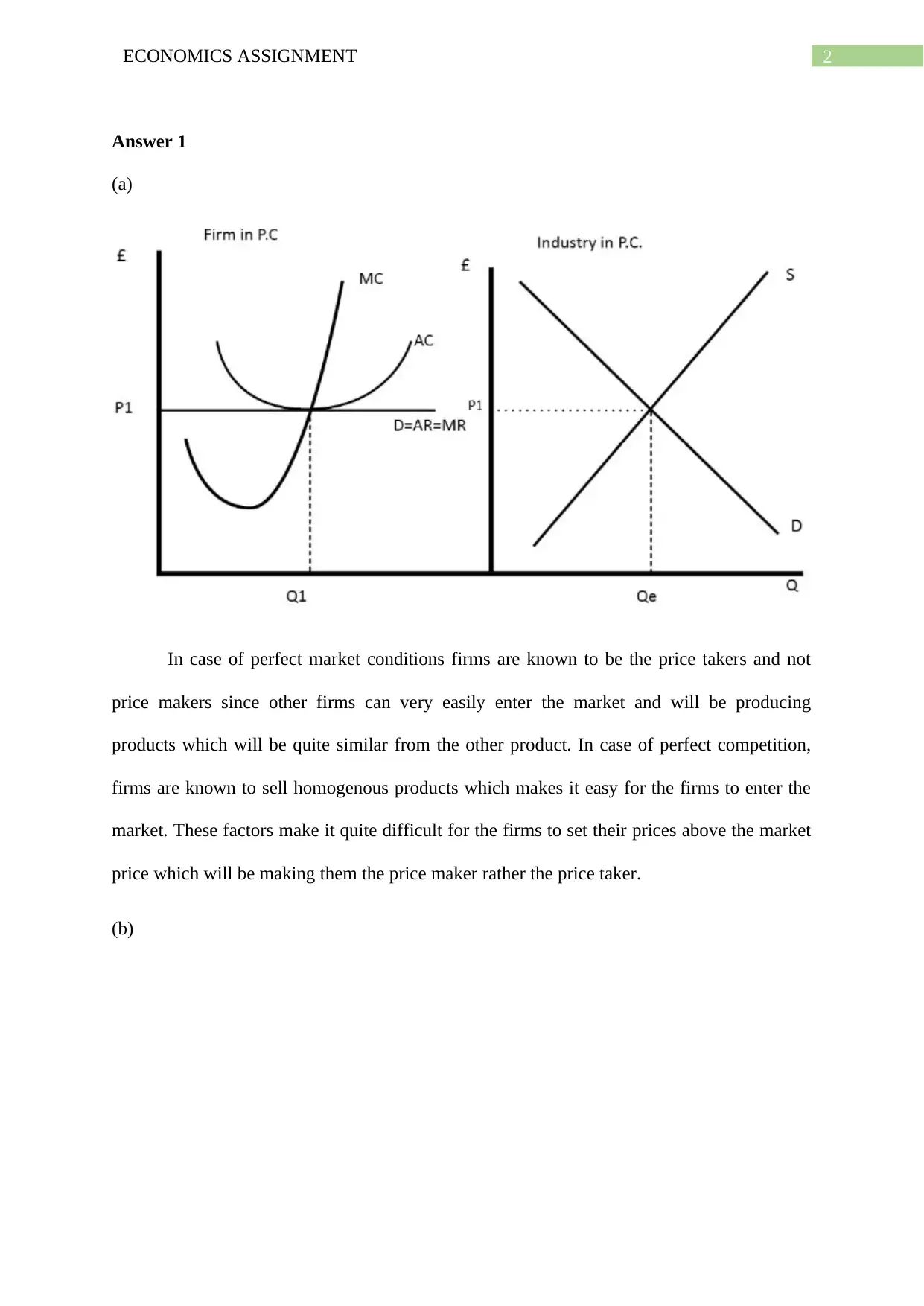
2ECONOMICS ASSIGNMENT
Answer 1
(a)
In case of perfect market conditions firms are known to be the price takers and not
price makers since other firms can very easily enter the market and will be producing
products which will be quite similar from the other product. In case of perfect competition,
firms are known to sell homogenous products which makes it easy for the firms to enter the
market. These factors make it quite difficult for the firms to set their prices above the market
price which will be making them the price maker rather the price taker.
(b)
Answer 1
(a)
In case of perfect market conditions firms are known to be the price takers and not
price makers since other firms can very easily enter the market and will be producing
products which will be quite similar from the other product. In case of perfect competition,
firms are known to sell homogenous products which makes it easy for the firms to enter the
market. These factors make it quite difficult for the firms to set their prices above the market
price which will be making them the price maker rather the price taker.
(b)
⊘ This is a preview!⊘
Do you want full access?
Subscribe today to unlock all pages.

Trusted by 1+ million students worldwide
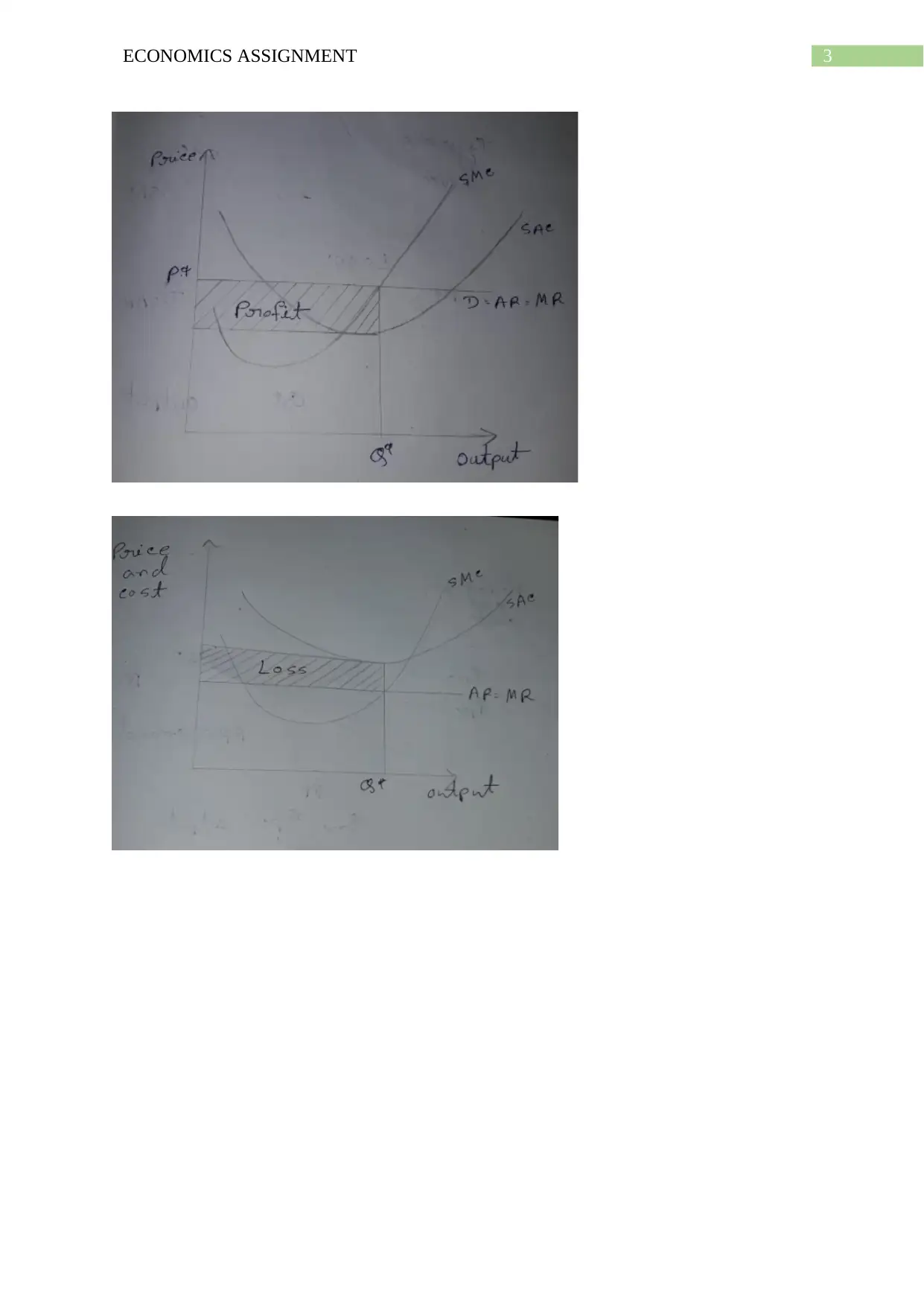
3ECONOMICS ASSIGNMENT
Paraphrase This Document
Need a fresh take? Get an instant paraphrase of this document with our AI Paraphraser
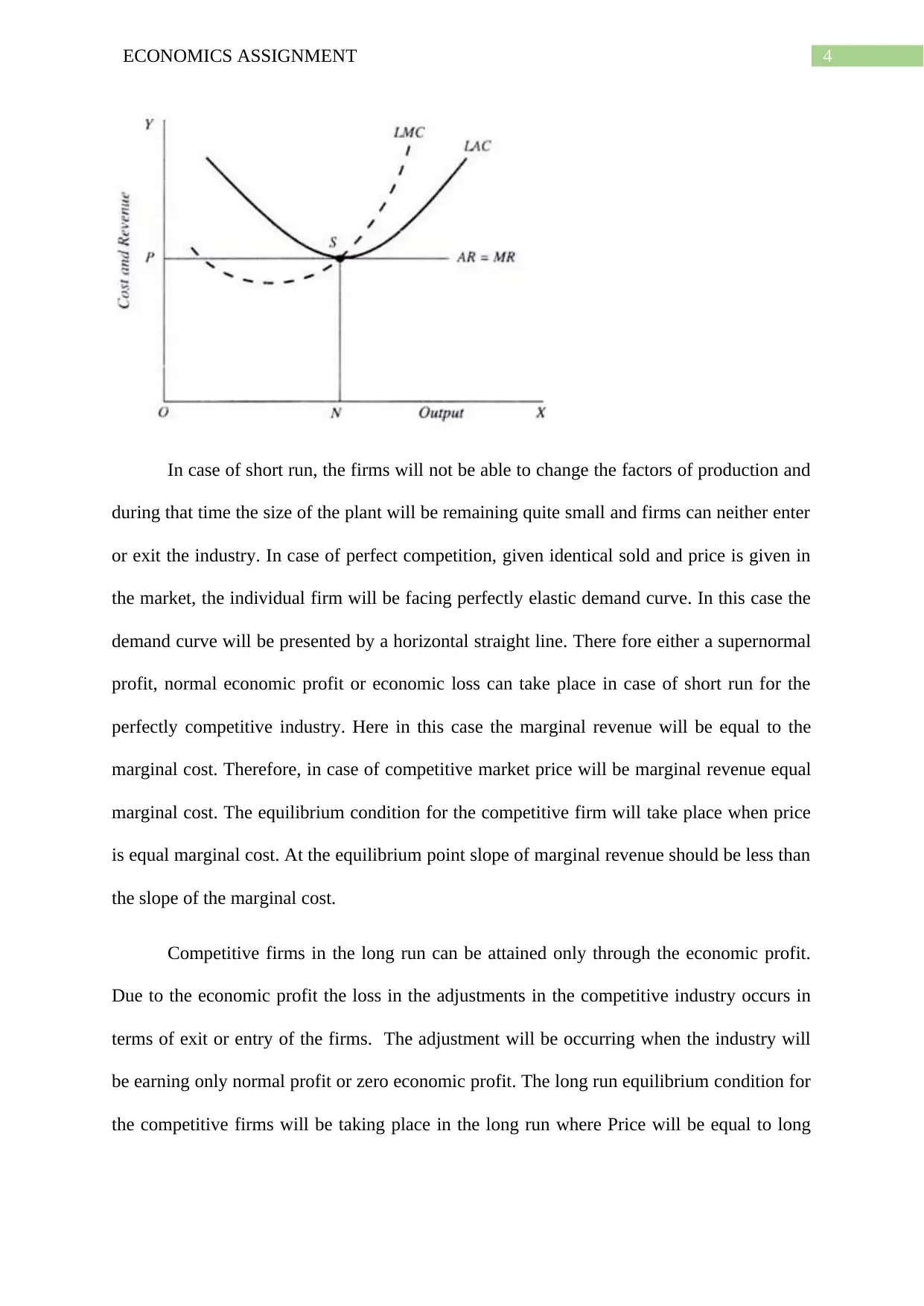
4ECONOMICS ASSIGNMENT
In case of short run, the firms will not be able to change the factors of production and
during that time the size of the plant will be remaining quite small and firms can neither enter
or exit the industry. In case of perfect competition, given identical sold and price is given in
the market, the individual firm will be facing perfectly elastic demand curve. In this case the
demand curve will be presented by a horizontal straight line. There fore either a supernormal
profit, normal economic profit or economic loss can take place in case of short run for the
perfectly competitive industry. Here in this case the marginal revenue will be equal to the
marginal cost. Therefore, in case of competitive market price will be marginal revenue equal
marginal cost. The equilibrium condition for the competitive firm will take place when price
is equal marginal cost. At the equilibrium point slope of marginal revenue should be less than
the slope of the marginal cost.
Competitive firms in the long run can be attained only through the economic profit.
Due to the economic profit the loss in the adjustments in the competitive industry occurs in
terms of exit or entry of the firms. The adjustment will be occurring when the industry will
be earning only normal profit or zero economic profit. The long run equilibrium condition for
the competitive firms will be taking place in the long run where Price will be equal to long
In case of short run, the firms will not be able to change the factors of production and
during that time the size of the plant will be remaining quite small and firms can neither enter
or exit the industry. In case of perfect competition, given identical sold and price is given in
the market, the individual firm will be facing perfectly elastic demand curve. In this case the
demand curve will be presented by a horizontal straight line. There fore either a supernormal
profit, normal economic profit or economic loss can take place in case of short run for the
perfectly competitive industry. Here in this case the marginal revenue will be equal to the
marginal cost. Therefore, in case of competitive market price will be marginal revenue equal
marginal cost. The equilibrium condition for the competitive firm will take place when price
is equal marginal cost. At the equilibrium point slope of marginal revenue should be less than
the slope of the marginal cost.
Competitive firms in the long run can be attained only through the economic profit.
Due to the economic profit the loss in the adjustments in the competitive industry occurs in
terms of exit or entry of the firms. The adjustment will be occurring when the industry will
be earning only normal profit or zero economic profit. The long run equilibrium condition for
the competitive firms will be taking place in the long run where Price will be equal to long
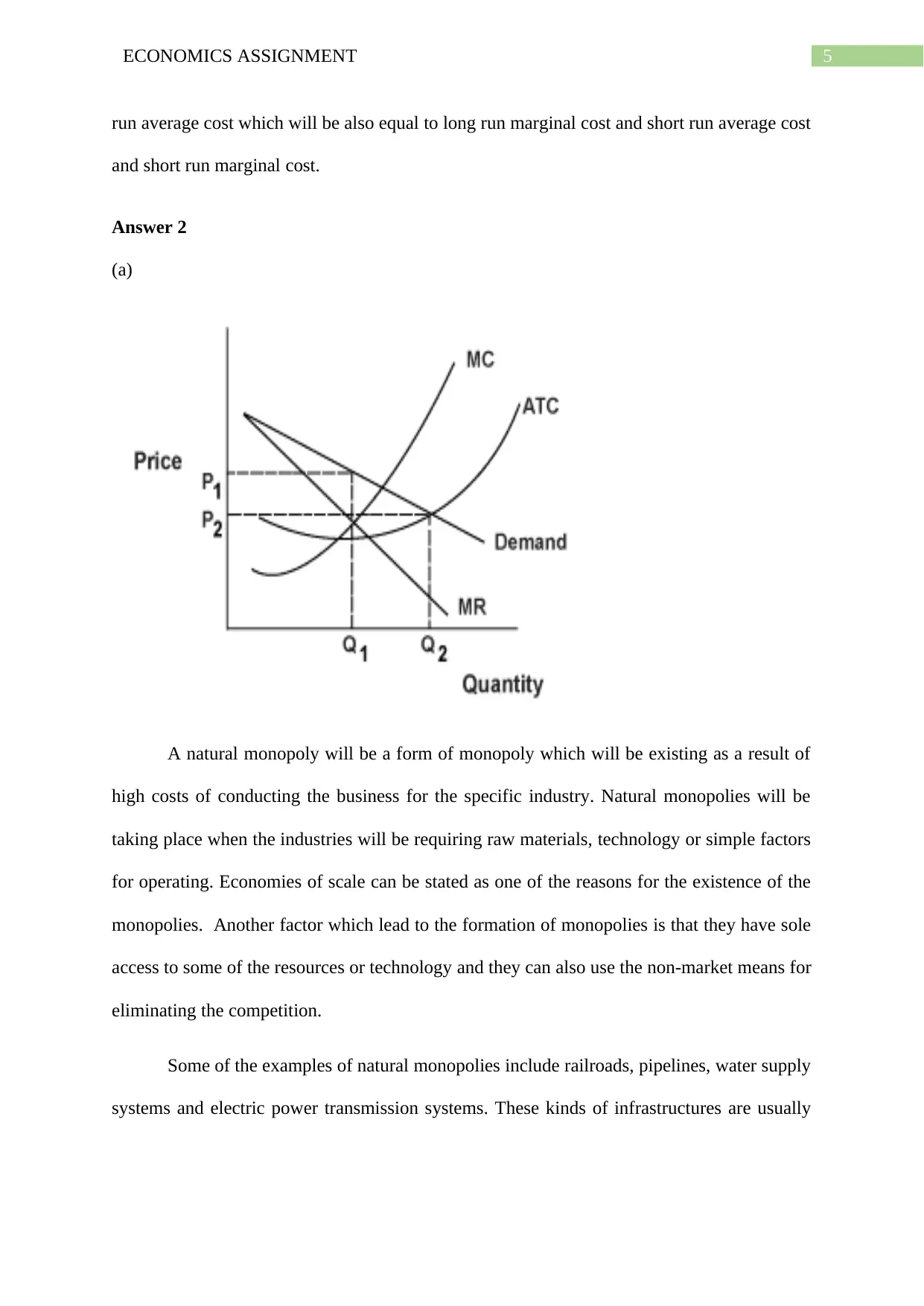
5ECONOMICS ASSIGNMENT
run average cost which will be also equal to long run marginal cost and short run average cost
and short run marginal cost.
Answer 2
(a)
A natural monopoly will be a form of monopoly which will be existing as a result of
high costs of conducting the business for the specific industry. Natural monopolies will be
taking place when the industries will be requiring raw materials, technology or simple factors
for operating. Economies of scale can be stated as one of the reasons for the existence of the
monopolies. Another factor which lead to the formation of monopolies is that they have sole
access to some of the resources or technology and they can also use the non-market means for
eliminating the competition.
Some of the examples of natural monopolies include railroads, pipelines, water supply
systems and electric power transmission systems. These kinds of infrastructures are usually
run average cost which will be also equal to long run marginal cost and short run average cost
and short run marginal cost.
Answer 2
(a)
A natural monopoly will be a form of monopoly which will be existing as a result of
high costs of conducting the business for the specific industry. Natural monopolies will be
taking place when the industries will be requiring raw materials, technology or simple factors
for operating. Economies of scale can be stated as one of the reasons for the existence of the
monopolies. Another factor which lead to the formation of monopolies is that they have sole
access to some of the resources or technology and they can also use the non-market means for
eliminating the competition.
Some of the examples of natural monopolies include railroads, pipelines, water supply
systems and electric power transmission systems. These kinds of infrastructures are usually
⊘ This is a preview!⊘
Do you want full access?
Subscribe today to unlock all pages.

Trusted by 1+ million students worldwide
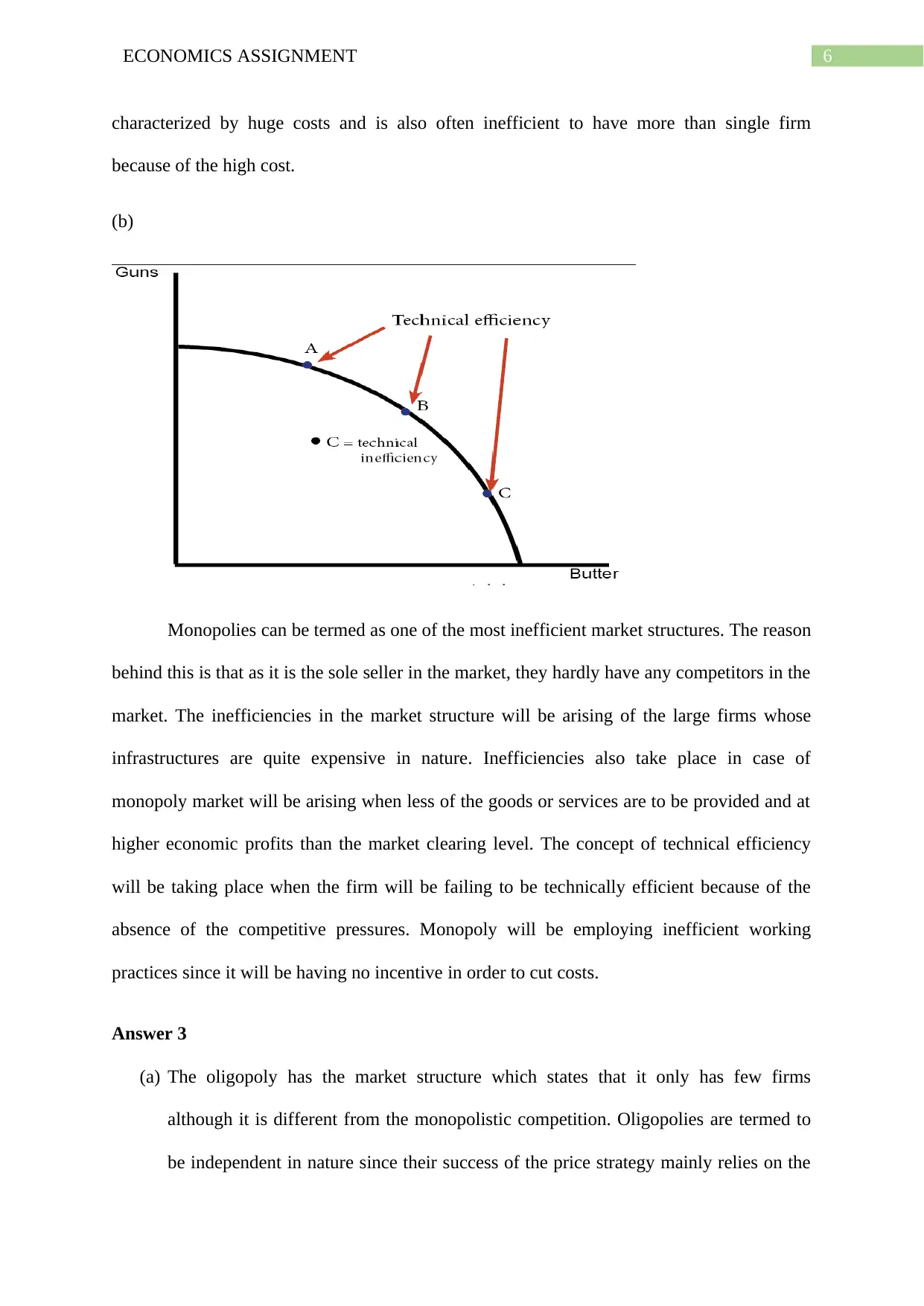
6ECONOMICS ASSIGNMENT
characterized by huge costs and is also often inefficient to have more than single firm
because of the high cost.
(b)
Monopolies can be termed as one of the most inefficient market structures. The reason
behind this is that as it is the sole seller in the market, they hardly have any competitors in the
market. The inefficiencies in the market structure will be arising of the large firms whose
infrastructures are quite expensive in nature. Inefficiencies also take place in case of
monopoly market will be arising when less of the goods or services are to be provided and at
higher economic profits than the market clearing level. The concept of technical efficiency
will be taking place when the firm will be failing to be technically efficient because of the
absence of the competitive pressures. Monopoly will be employing inefficient working
practices since it will be having no incentive in order to cut costs.
Answer 3
(a) The oligopoly has the market structure which states that it only has few firms
although it is different from the monopolistic competition. Oligopolies are termed to
be independent in nature since their success of the price strategy mainly relies on the
characterized by huge costs and is also often inefficient to have more than single firm
because of the high cost.
(b)
Monopolies can be termed as one of the most inefficient market structures. The reason
behind this is that as it is the sole seller in the market, they hardly have any competitors in the
market. The inefficiencies in the market structure will be arising of the large firms whose
infrastructures are quite expensive in nature. Inefficiencies also take place in case of
monopoly market will be arising when less of the goods or services are to be provided and at
higher economic profits than the market clearing level. The concept of technical efficiency
will be taking place when the firm will be failing to be technically efficient because of the
absence of the competitive pressures. Monopoly will be employing inefficient working
practices since it will be having no incentive in order to cut costs.
Answer 3
(a) The oligopoly has the market structure which states that it only has few firms
although it is different from the monopolistic competition. Oligopolies are termed to
be independent in nature since their success of the price strategy mainly relies on the
Paraphrase This Document
Need a fresh take? Get an instant paraphrase of this document with our AI Paraphraser
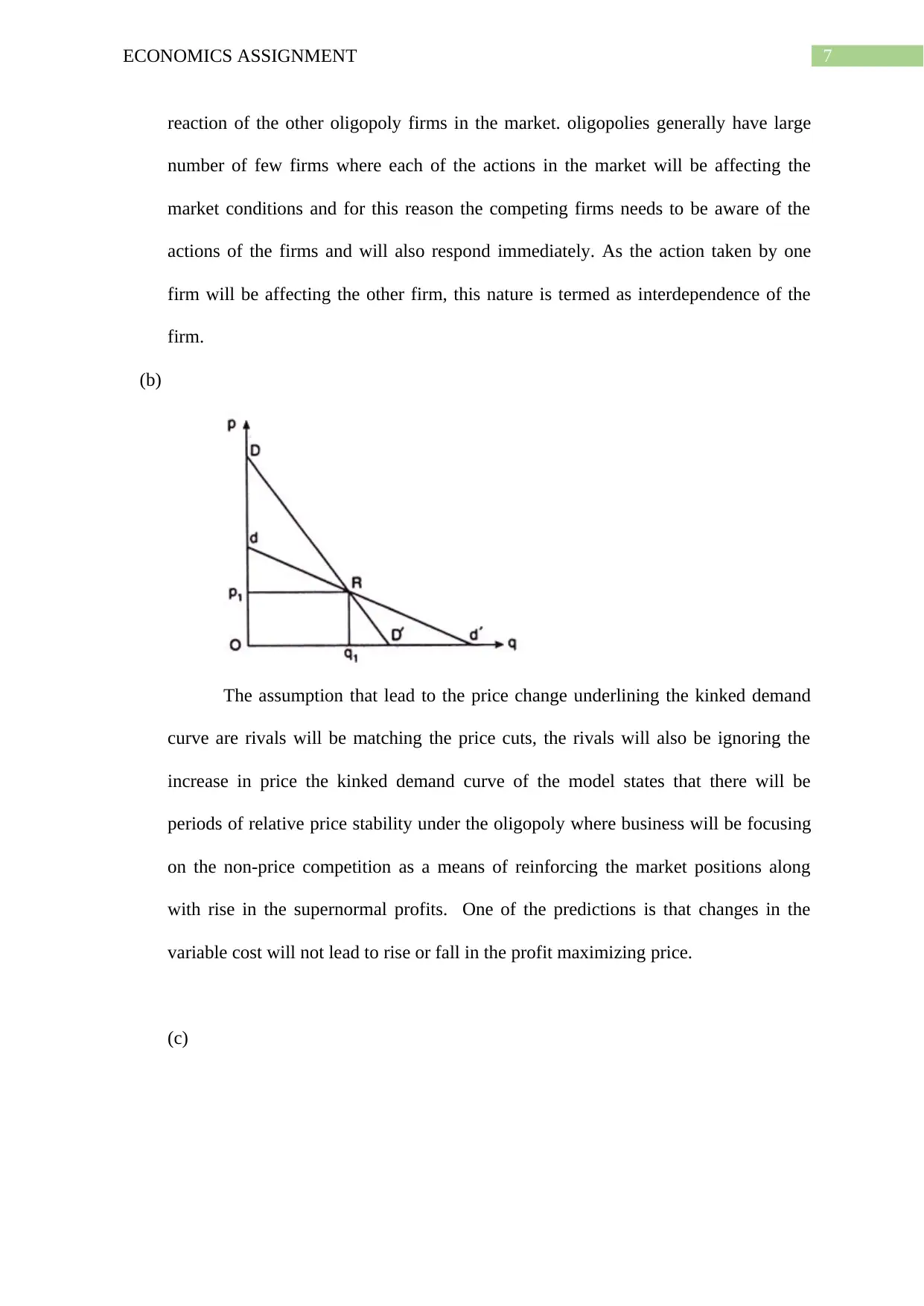
7ECONOMICS ASSIGNMENT
reaction of the other oligopoly firms in the market. oligopolies generally have large
number of few firms where each of the actions in the market will be affecting the
market conditions and for this reason the competing firms needs to be aware of the
actions of the firms and will also respond immediately. As the action taken by one
firm will be affecting the other firm, this nature is termed as interdependence of the
firm.
(b)
The assumption that lead to the price change underlining the kinked demand
curve are rivals will be matching the price cuts, the rivals will also be ignoring the
increase in price the kinked demand curve of the model states that there will be
periods of relative price stability under the oligopoly where business will be focusing
on the non-price competition as a means of reinforcing the market positions along
with rise in the supernormal profits. One of the predictions is that changes in the
variable cost will not lead to rise or fall in the profit maximizing price.
(c)
reaction of the other oligopoly firms in the market. oligopolies generally have large
number of few firms where each of the actions in the market will be affecting the
market conditions and for this reason the competing firms needs to be aware of the
actions of the firms and will also respond immediately. As the action taken by one
firm will be affecting the other firm, this nature is termed as interdependence of the
firm.
(b)
The assumption that lead to the price change underlining the kinked demand
curve are rivals will be matching the price cuts, the rivals will also be ignoring the
increase in price the kinked demand curve of the model states that there will be
periods of relative price stability under the oligopoly where business will be focusing
on the non-price competition as a means of reinforcing the market positions along
with rise in the supernormal profits. One of the predictions is that changes in the
variable cost will not lead to rise or fall in the profit maximizing price.
(c)
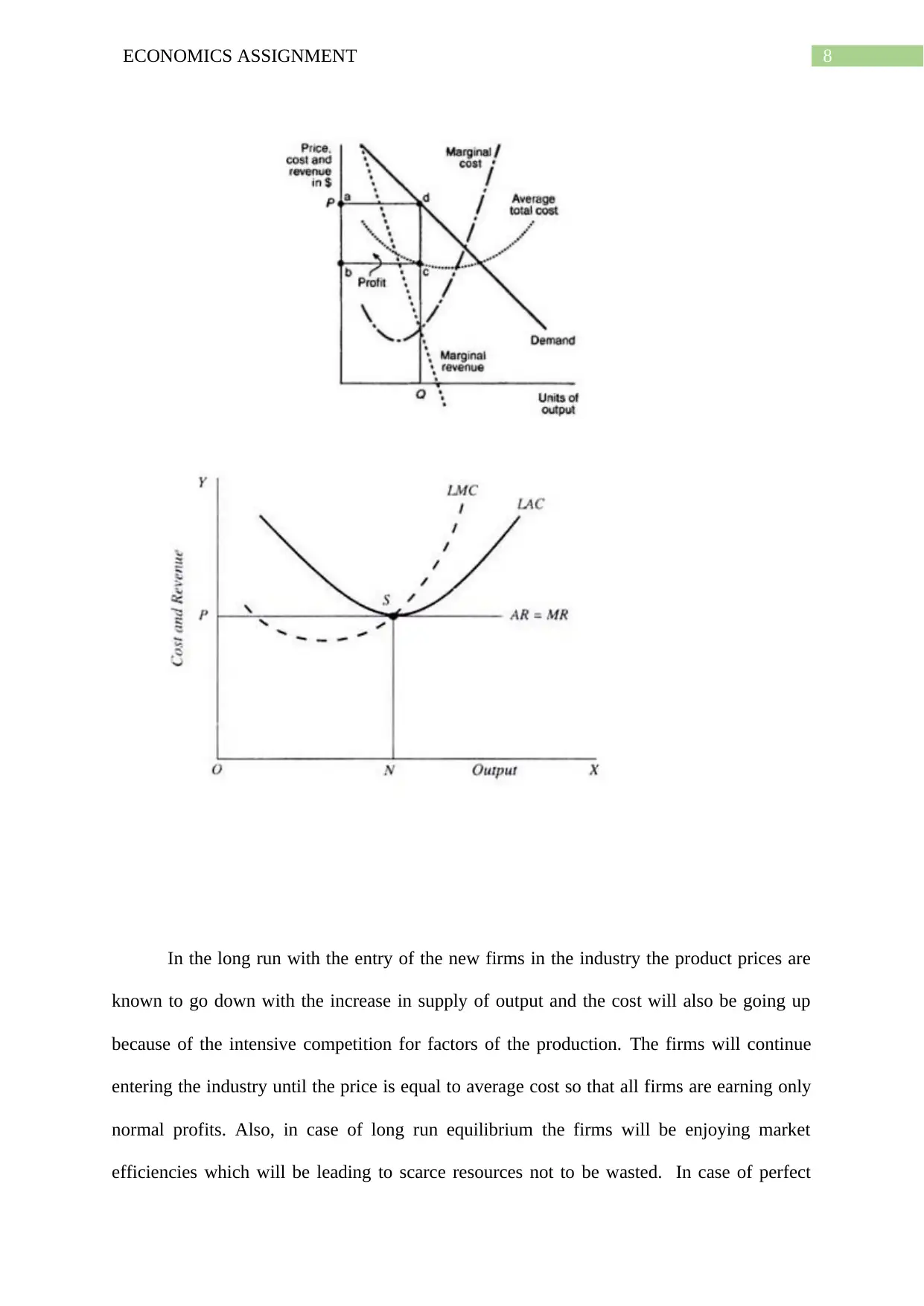
8ECONOMICS ASSIGNMENT
In the long run with the entry of the new firms in the industry the product prices are
known to go down with the increase in supply of output and the cost will also be going up
because of the intensive competition for factors of the production. The firms will continue
entering the industry until the price is equal to average cost so that all firms are earning only
normal profits. Also, in case of long run equilibrium the firms will be enjoying market
efficiencies which will be leading to scarce resources not to be wasted. In case of perfect
In the long run with the entry of the new firms in the industry the product prices are
known to go down with the increase in supply of output and the cost will also be going up
because of the intensive competition for factors of the production. The firms will continue
entering the industry until the price is equal to average cost so that all firms are earning only
normal profits. Also, in case of long run equilibrium the firms will be enjoying market
efficiencies which will be leading to scarce resources not to be wasted. In case of perfect
⊘ This is a preview!⊘
Do you want full access?
Subscribe today to unlock all pages.

Trusted by 1+ million students worldwide
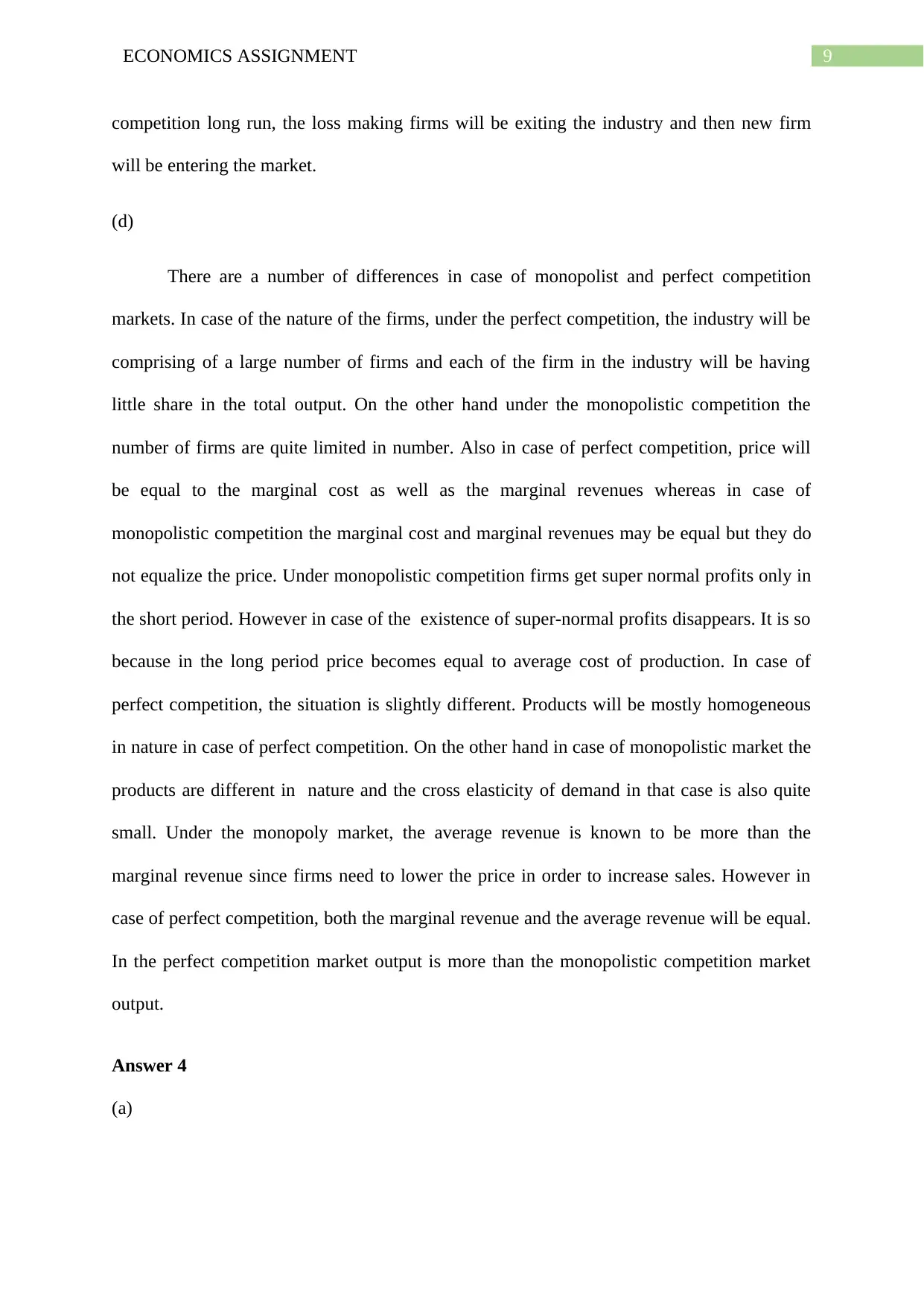
9ECONOMICS ASSIGNMENT
competition long run, the loss making firms will be exiting the industry and then new firm
will be entering the market.
(d)
There are a number of differences in case of monopolist and perfect competition
markets. In case of the nature of the firms, under the perfect competition, the industry will be
comprising of a large number of firms and each of the firm in the industry will be having
little share in the total output. On the other hand under the monopolistic competition the
number of firms are quite limited in number. Also in case of perfect competition, price will
be equal to the marginal cost as well as the marginal revenues whereas in case of
monopolistic competition the marginal cost and marginal revenues may be equal but they do
not equalize the price. Under monopolistic competition firms get super normal profits only in
the short period. However in case of the existence of super-normal profits disappears. It is so
because in the long period price becomes equal to average cost of production. In case of
perfect competition, the situation is slightly different. Products will be mostly homogeneous
in nature in case of perfect competition. On the other hand in case of monopolistic market the
products are different in nature and the cross elasticity of demand in that case is also quite
small. Under the monopoly market, the average revenue is known to be more than the
marginal revenue since firms need to lower the price in order to increase sales. However in
case of perfect competition, both the marginal revenue and the average revenue will be equal.
In the perfect competition market output is more than the monopolistic competition market
output.
Answer 4
(a)
competition long run, the loss making firms will be exiting the industry and then new firm
will be entering the market.
(d)
There are a number of differences in case of monopolist and perfect competition
markets. In case of the nature of the firms, under the perfect competition, the industry will be
comprising of a large number of firms and each of the firm in the industry will be having
little share in the total output. On the other hand under the monopolistic competition the
number of firms are quite limited in number. Also in case of perfect competition, price will
be equal to the marginal cost as well as the marginal revenues whereas in case of
monopolistic competition the marginal cost and marginal revenues may be equal but they do
not equalize the price. Under monopolistic competition firms get super normal profits only in
the short period. However in case of the existence of super-normal profits disappears. It is so
because in the long period price becomes equal to average cost of production. In case of
perfect competition, the situation is slightly different. Products will be mostly homogeneous
in nature in case of perfect competition. On the other hand in case of monopolistic market the
products are different in nature and the cross elasticity of demand in that case is also quite
small. Under the monopoly market, the average revenue is known to be more than the
marginal revenue since firms need to lower the price in order to increase sales. However in
case of perfect competition, both the marginal revenue and the average revenue will be equal.
In the perfect competition market output is more than the monopolistic competition market
output.
Answer 4
(a)
Paraphrase This Document
Need a fresh take? Get an instant paraphrase of this document with our AI Paraphraser
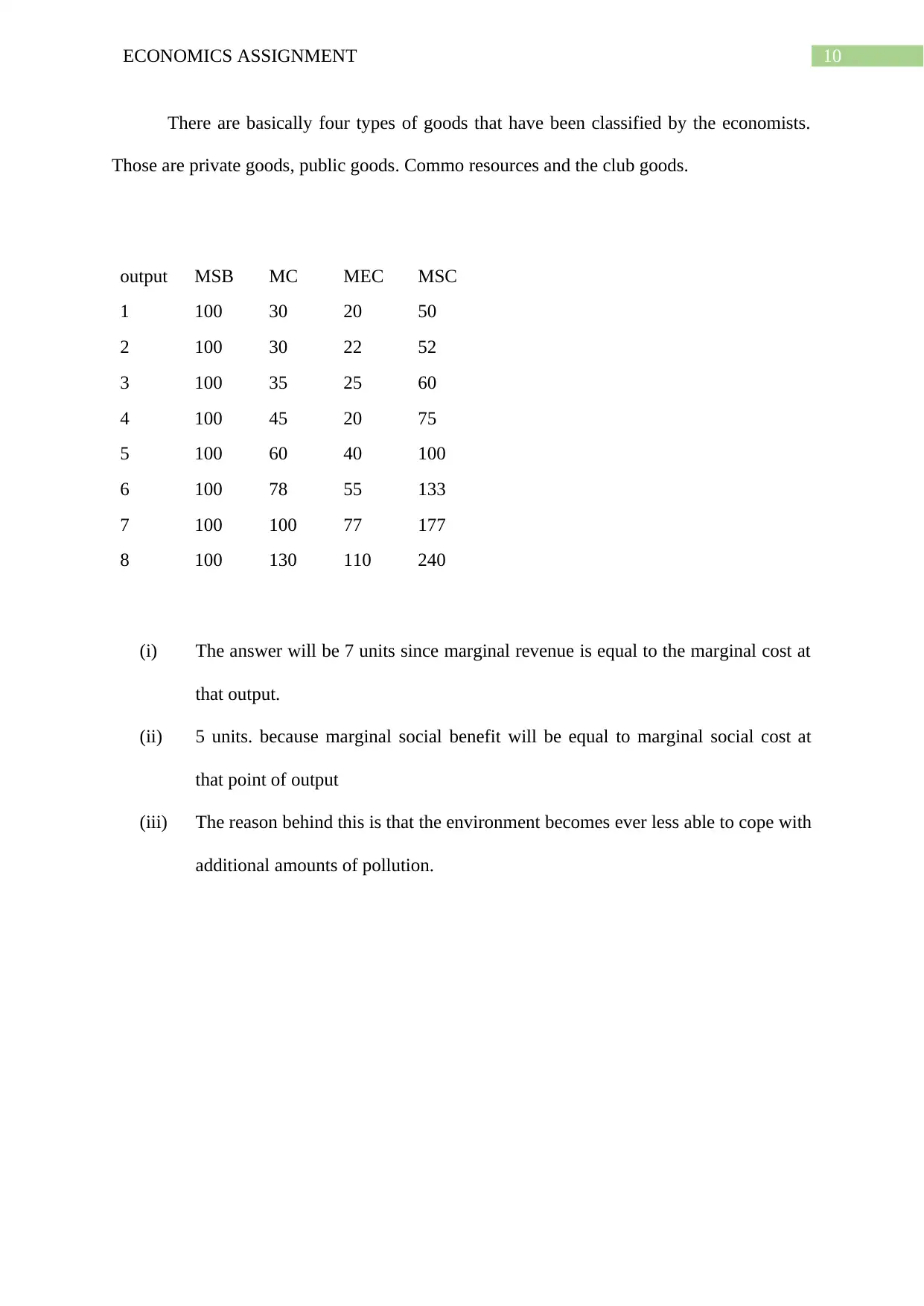
10ECONOMICS ASSIGNMENT
There are basically four types of goods that have been classified by the economists.
Those are private goods, public goods. Commo resources and the club goods.
output MSB MC MEC MSC
1 100 30 20 50
2 100 30 22 52
3 100 35 25 60
4 100 45 20 75
5 100 60 40 100
6 100 78 55 133
7 100 100 77 177
8 100 130 110 240
(i) The answer will be 7 units since marginal revenue is equal to the marginal cost at
that output.
(ii) 5 units. because marginal social benefit will be equal to marginal social cost at
that point of output
(iii) The reason behind this is that the environment becomes ever less able to cope with
additional amounts of pollution.
There are basically four types of goods that have been classified by the economists.
Those are private goods, public goods. Commo resources and the club goods.
output MSB MC MEC MSC
1 100 30 20 50
2 100 30 22 52
3 100 35 25 60
4 100 45 20 75
5 100 60 40 100
6 100 78 55 133
7 100 100 77 177
8 100 130 110 240
(i) The answer will be 7 units since marginal revenue is equal to the marginal cost at
that output.
(ii) 5 units. because marginal social benefit will be equal to marginal social cost at
that point of output
(iii) The reason behind this is that the environment becomes ever less able to cope with
additional amounts of pollution.
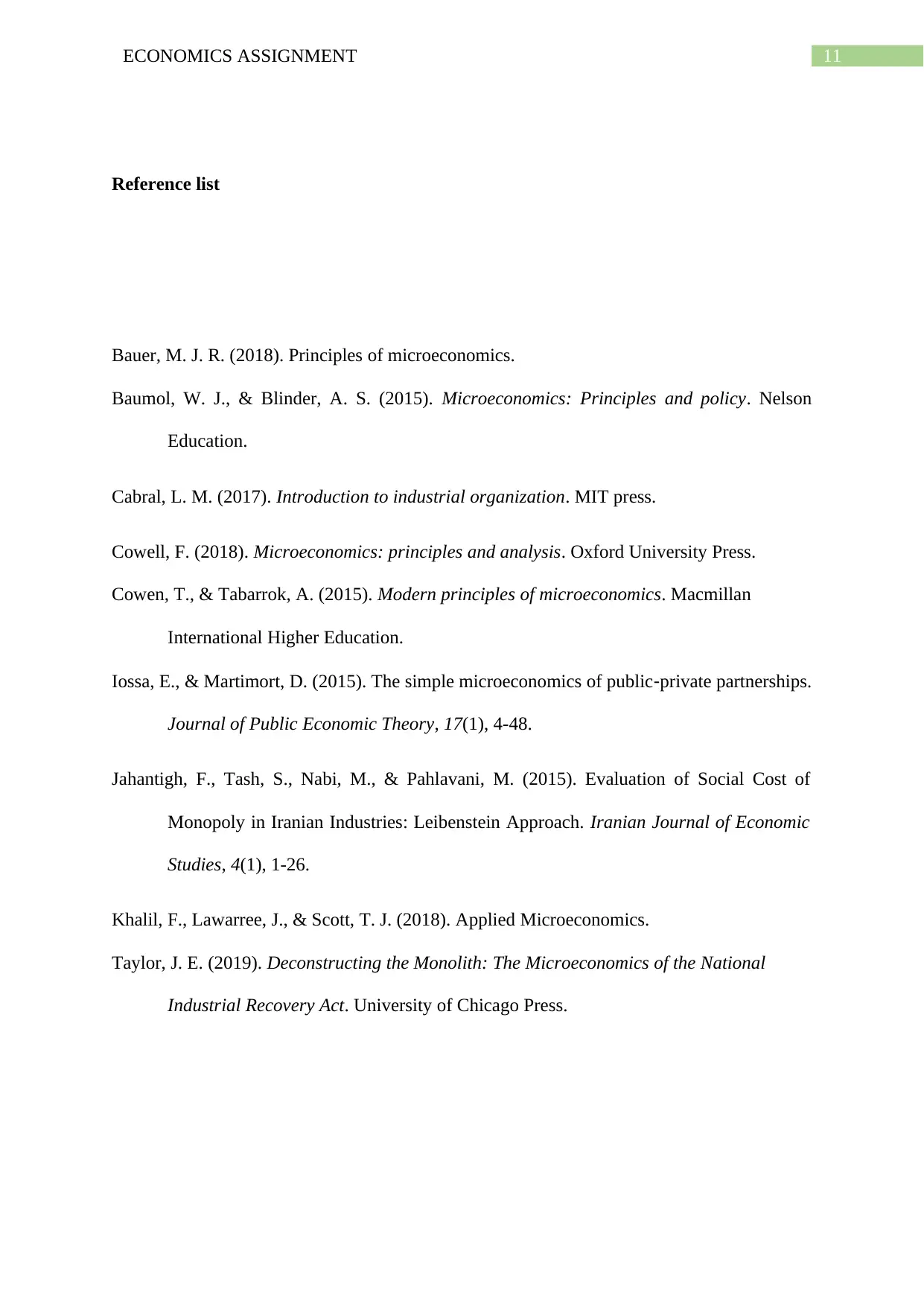
11ECONOMICS ASSIGNMENT
Reference list
Bauer, M. J. R. (2018). Principles of microeconomics.
Baumol, W. J., & Blinder, A. S. (2015). Microeconomics: Principles and policy. Nelson
Education.
Cabral, L. M. (2017). Introduction to industrial organization. MIT press.
Cowell, F. (2018). Microeconomics: principles and analysis. Oxford University Press.
Cowen, T., & Tabarrok, A. (2015). Modern principles of microeconomics. Macmillan
International Higher Education.
Iossa, E., & Martimort, D. (2015). The simple microeconomics of public‐private partnerships.
Journal of Public Economic Theory, 17(1), 4-48.
Jahantigh, F., Tash, S., Nabi, M., & Pahlavani, M. (2015). Evaluation of Social Cost of
Monopoly in Iranian Industries: Leibenstein Approach. Iranian Journal of Economic
Studies, 4(1), 1-26.
Khalil, F., Lawarree, J., & Scott, T. J. (2018). Applied Microeconomics.
Taylor, J. E. (2019). Deconstructing the Monolith: The Microeconomics of the National
Industrial Recovery Act. University of Chicago Press.
Reference list
Bauer, M. J. R. (2018). Principles of microeconomics.
Baumol, W. J., & Blinder, A. S. (2015). Microeconomics: Principles and policy. Nelson
Education.
Cabral, L. M. (2017). Introduction to industrial organization. MIT press.
Cowell, F. (2018). Microeconomics: principles and analysis. Oxford University Press.
Cowen, T., & Tabarrok, A. (2015). Modern principles of microeconomics. Macmillan
International Higher Education.
Iossa, E., & Martimort, D. (2015). The simple microeconomics of public‐private partnerships.
Journal of Public Economic Theory, 17(1), 4-48.
Jahantigh, F., Tash, S., Nabi, M., & Pahlavani, M. (2015). Evaluation of Social Cost of
Monopoly in Iranian Industries: Leibenstein Approach. Iranian Journal of Economic
Studies, 4(1), 1-26.
Khalil, F., Lawarree, J., & Scott, T. J. (2018). Applied Microeconomics.
Taylor, J. E. (2019). Deconstructing the Monolith: The Microeconomics of the National
Industrial Recovery Act. University of Chicago Press.
⊘ This is a preview!⊘
Do you want full access?
Subscribe today to unlock all pages.

Trusted by 1+ million students worldwide
1 out of 13
Related Documents
Your All-in-One AI-Powered Toolkit for Academic Success.
+13062052269
info@desklib.com
Available 24*7 on WhatsApp / Email
![[object Object]](/_next/static/media/star-bottom.7253800d.svg)
Unlock your academic potential
Copyright © 2020–2025 A2Z Services. All Rights Reserved. Developed and managed by ZUCOL.




